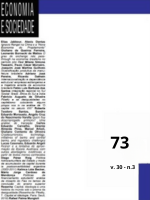Abstract
The purpose of this study is to show that, in both the Hansen and Summers versions, the secular stagnation hypothesis is based on questionable theoretical foundations that seem inconsistent both with the neoclassical approach to growth and with the heterodox models of demand-led growth. We build on F. Petri´s recent critique of the incoherent use of the neoclassical investment function in situations with persistent labor unemployment, and show that the recent debate is directly connected with the old debate about the two problems raised by R. Harrod. The analysis allows us to understand some questions related to the current debate, such as the Gordon-Summers controversy on whether the causes of the recent stagnation tendencies in developed countries should be attributed to supply or demand factors.
References
ALLAIN, O. Demographic growth, Harrodian (in)stability and the supermultiplier. Cambridge Journal of Economics, Feb. 2018.
CESARATTO, S.; SERRANO, F.; STIRATI, A. Technical change, effective demand and employment. Review of Political Economy, v. 15, n. 1, p. 33-52, 2003.
DELEIDE, M.; MAZZUCATO, M. Putting austerity to bed: technical progress, aggregate demand and the supermultiplier. UCL Institute for Innovation and Public Purpose, 2018. (Working Paper Series, 2018-01).
FAZZARI, S.; FERRI, P.; VARIATO, A. Demand-led growth and accommodating supply. 2017. (Working Paper). Available at: http://pages.wustl.edu/fazz/papers
GIRARDI, D.; PATERNESI MELONI, W.; STIRATI, A. Persistent effects of autonomous demand expansions. Institute for New Economic Thinking, Feb. 2018. (Working Paper, n. 70).
GAREGNANI, P. Notes on consumption, investment and effective demand. Cambridge Journal of Economics, v. 2, p. 335-353; v. 3, p. 63-82, 1978-79. Reprinted in: Eatwell e Milgate (1983).
GORDON, R. Secular stagnation: a supply-side view. The American Economic Review, v. 105, n. 5, p. 54-59, 2015.
HARROD, R. An essay in dynamic theory. The Economic Journal, v. 49, n. 193, p. 14-33, 1939.
HARROD, R. Towards a dynamic economics. London: Macmillan, 1948.
HANSEN, A. H. Economic progress and declining population growth. The American Economic Review , v. 29, n. 1, p. 1-15, 1939.
LAVOIE, M. Post Keynesian economics: new foundations. Edward Elgar, 2014.
NAH, W.; LAVOIE, M. Convergence in a neo-Kaleckian model with endogenous technical progress and autonomous demand growth. 2017. Disponivel em: https://www.boeckler.de/pdf/v_2017_11_11_lavoie.pdf
PETRI, F. The inevitable dependence of investment on expected demand: implications for neoclassical macroeconomics. In: LEVRERO, S. (Org.). Sraffa and the reconstruction of economic theory. 2013. v. 2, p. 44-67.
PETRI, F. Neglected implications of neoclassical capital-labour substitution for investment theory: another criticism of Say’s law. Review of Political Economy , v. 27, n. 3, 2015.
SERRANO, F.; FREITAS, F. The Sraffian supermultiplier as an alternative closure for heterodox growth theory. European Journal of Economics and Economic Policy: Intervention, v. 14, n. 1, p. 70-91, 2017. DOI: 10.4337/ejeep.2017.01.06.
SERRANO, F.; FREITAS, F.; BHERING, G. The trouble with Harrod: the fundamental instability of the warranted rate in the light of the Sraffian supermultiplier. Metroeconomica, v. 70, n. 2, p. 263-287, 2019. DOI: 10.1111/meca.12230.
SERRANO, F.; FREITAS, F.; BHERING, G. O supermultiplicador sraffiano, a instabilidade fundamental de Harrod e o dilema de “Oxbridge”. Análise Econômica, v. 38, n. 77, 2019. DOI: /10.22456/2176-5456.7828.
SOLOW, R. A contribution to the theory of economic growth. The Quarterly Journal of Economics, v. 70, n. 1, p. 65-94, Feb. 1956.
SUMMERS, L. Reflections on the ‘new secular stagnation hypothesis’. Secular stagnation: facts, causes and cures. VOXEU-CEPR, 2014. p. 27-38.
SUMMERS, L. Demand side secular stagnation. The American Economic Review , v. 105, n. 5, p. 60-65, 2015.

This work is licensed under a Creative Commons Attribution 4.0 International License.
Copyright (c) 2021 Vivian Garrido Moreira, Franklin Serrano


